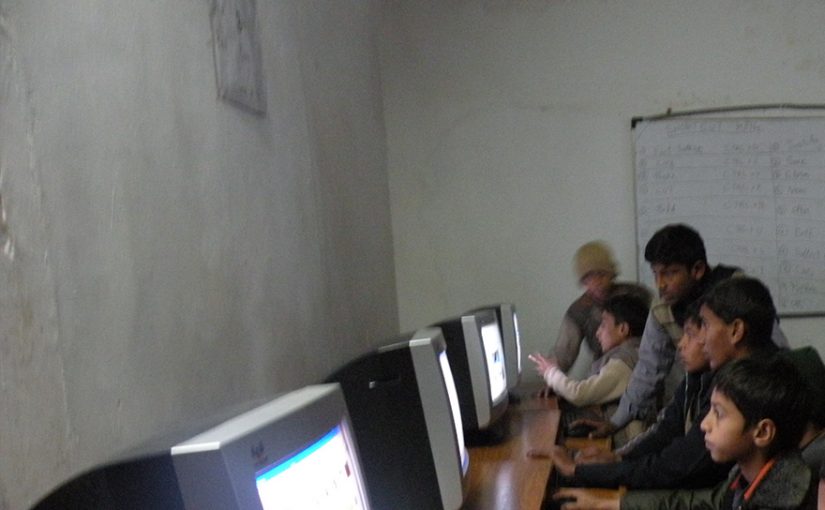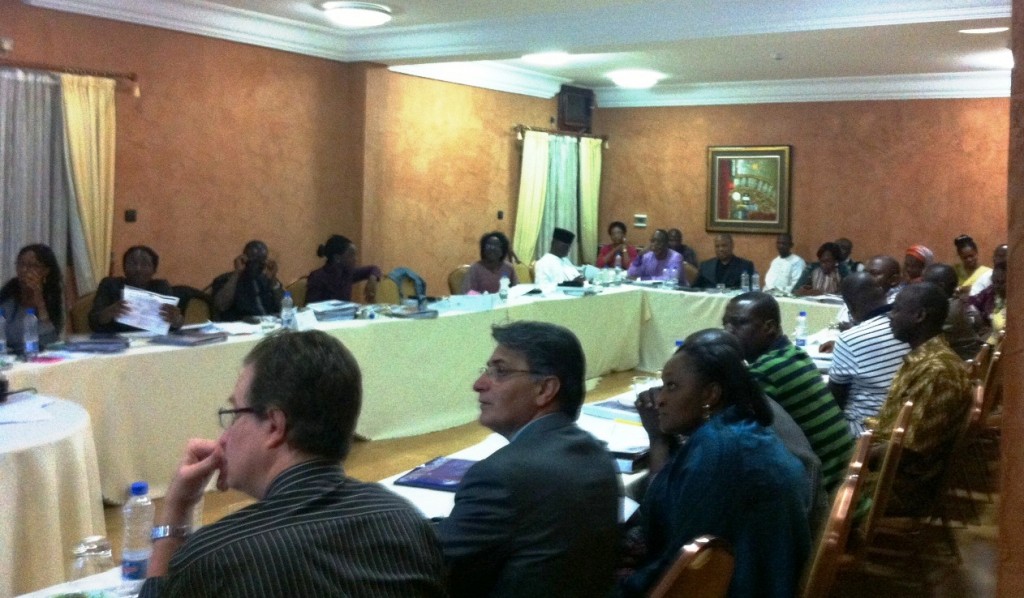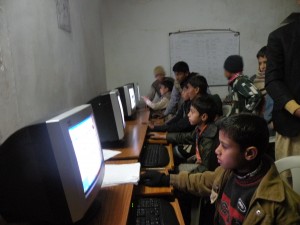Parvez Iftikhar is the CEO of the Universal Service Fund and spoke on the Business Technology Challenges in session 1 of the CIOYearAhead’09. Here’s what his comments were, at the end of the event.
Author: admin
Parvez Iftikhar Gives an Update of USF’s Recent Achievement!
Parvez Iftikhar, CEO of the Universal Service Fund, gives CIO Pakistan an audio update about the organization’s recent achievements. USF signed two contracts on the 28th of July, 2009 – one with CMPak for a worth of Rs.1.5 billion for basic telecom in Nasirabad and Balochistan, and another with WorldCall for broadband in Southern Punjab MTR worth Rs.785 million. The USF CEO answered a few quick questions we had so we could bring our listeners an update on the work that USF is doing in Pakistan.

My first visit to Nigeria

USPF Nigeria was established under the National Communications Act 2003 and has not been doing really well, though still one of the best in Africa. In 5 years it has not achieved what it set to achieve – internet to 474 schools country-wide is the biggest achievement that one speaks about. And even here the target was far higher. Other than that they have set up some Community Communication Centers (CCCs) and installed 50 to 60 BTS towers. USPF Nigeria is a part of the Telecom Regulator NCC (Nigerian Communications Commission), which in turn is run by capable and experienced persons like Chairman (Peter Igoh) and Executive Vice-Chairman (Eugene Juwah).
The Minister, Ms Omobola Johnson, an Electronics Engineer from University of Manchester, was previously Country Managing Director of Accenture in Nigeria. She took over the newly formed Ministry 6 months ago and says that she is convinced that ICT infrastructure is as important as roads, rail and power networks and that Broadband network penetration in Nigeria should be doubled to 12% in 3 years. The draft of new ICT Policy, which also calls for a converged regulator, has been issued. And towards the end of 2011 USPF also got a new Head (they call it Secretary USPF) Abdullahi Maikano who was formerly head of projects at NCC. Abdullahi Maikano (ably assisted by Kelechi Nwankwo) looks really excited in his new job and shows a great passion of wanting to make a difference.
One of the steps taken, under guidance of Ms Johnson, in order to revitalize USPF was to organize a two-day “retreat” – a gathering of all the Government-side players involved with USPF, like: Ministry, Regulator, Advisors, USPF Board Members, USPF Management, etc. together with the consultants (USAID/GBI’s David Townsend, myself and the KPMG team, who was also responsible for conducting and moderating the event, which they did marvelously) at Abuja. The objective of it all was to work out a Strategic Management Plan (SMP) for USPF. An SMP including redefining USPF’s Vision and Mission statements, its goals, KPIs and the way forward to achieve those.
A typical private sector-like exercise, the retreat started on Friday morning 9 am and continued right up to Saturday evening 9 pm – both days, 12-hours each! 24 hours of grueling work during the 2 days included presentations, discussions, debates, analyses and breakout workshop sessions. Thirty people and not one did I notice looking at his/her watch even after 6 pm. Since the setting was not very formal, the atmosphere remained pleasant, plus don’t forget the Nigerians are jovial people! The entire event proceeded smoothly in a very professional manner, proving all those negative stories about Nigerians as utter crap. Even otherwise, I found the Nigerians to be very friendly and helpful.
Some of the issues and apprehensions raised by the participants sounded very familiar, just as in almost all other countries one goes to. One of the main apprehensions being that the government will take away the money that has been collected so far and use it elsewhere! If you talk to the universal service responsible persons, they always complain that it is the government itself that delays utilization of the fund.
The most satisfying outcome was that now there is an SMP (which includes recommendation about capacity building within USPF) with direct contributions – and thus the ownership – of everyone, from the Minister to the junior officials of NCC/USPF and of course the consultants! With all on board, success is bound to come. This is a great example for all the USFs of the world that should be emulated globally. In fact it should be repeated every year to review the progress.
So what was it that I found so amazing about Minister Omobola Johnson? Well, the amazing thing was that not only did she sit through the entire two twelve-hour sessions but was one of the most active participants throughout. I guess that is the advantage of having a dedicated Minister who also knows the subject – especially if it’s a technical one like ICT.

Is broadband important for us?

Examples like the one above from the cellphone world are numerous but wherever broadband is becoming available, similar examples are coming to light too. When former colleague Tahira Malik visited a ‘ladies only computer center’ in Balochistan (to which USF had provided broadband) the purdah-observing ladies were thrilled to find out that not only could they learn new embroidery-stitches and new recipes from YouTube, they could also learn how to make themselves up, like those gorgeously made-up ladies on television! Soon they were googling on their own! A remarkable comment was: “Yeh google tau ek jinn hai”! (This google is a genie). Simultaneously at some other telecenters, one could find boys thrilled at discovering that not only was it possible to see their houses on Google Earth, it was also actually possible to earn from the web.

I keep coming across detractors who, somewhat skeptically, ask what will we do with broadband? Can broadband create jobs? Can broadband educate? What would be it’s impact on the GDP?
Let’s take the most important issue for us, Education. ‘Khan Academy’ in US (www.khanacademy.org), set up by Mr Salman Khan, whose family migrated from Bangladesh, has millions learning from it’s 3,000+ (and growing) educational videos – a shining example of how broadband can help educate masses. Today YouTube has over 100 million views of Khan Academy. MIT’s Opencourseware is another such website with 32 million views. The videos are being translated in many languages. Imagine the potential!
For those looking for higher levels, digitization is making more and more information available via broadband. E-newspapers, e-books, on-line scientific journals and digital libraries are changing the pattern of access to valuable content and modifying the way we read or do research
As Secretary Gen. ITU recently stated, two of the biggest universities in the world today specialize in distance learning – Indira Gandhi National Open University in New Delhi (3.5 million students) and Allama Iqbal Open University in Islamabad (1.8 million students). On the other hand ICTs and broadband have brought the death of distance. Imagine the potential when Broadband and Open Universities team-up!
It must be kept in mind that broadband is not an end in itself. It is an important means of meeting a wide variety of goals in highly diverse sectors – commerce, finance, government, healthcare, banking, scientific research, environmental sustainability, timely warning of natural disasters, climate change, smart electric grids, etc. etc. For those of us who have seen it work in some other countries, it is something as obvious as daylight. But for many perhaps one needs to refer to those hundreds of research reports and case studies on the economic effects of providing broadband access that are available for all to see. For example:
- In China, every 10% increase in broadband penetration is seen as contributing additional 2.5% to GDP growth.
- McKinsey & Company, “Mobile Broadband for the Masses” (2009), estimate that “10% increase in broadband penetration delivers a boost to a country’s GDP that ranges from 0.1 to 1.4 percent”.
- An analysis of the European Commission that estimates broadband is creating more than two million jobs in Europe by 2015 and an increase in GDP of at least EUR 636 billion.
- In Thailand, where in 2010 only 3% of households had broadband, it has been forecast that it could add 2.4% per cent to the country’s GDP growth rate.
- A 2009 study by Booz & Company, “Digital Highways: The Role of Governments in 21st Century Infrastructures”, found that “10% higher broadband penetration in a specific year is correlated with 1.5% greater labour productivity growth over the following five years”. The report also suggests that “countries in the top tier of broadband penetration have exhibited 2% higher GDP growth than countries in the bottom tier”.
- According to a study by the World Bank, it provides 1.38 additional percentage points to GDP growth for every 10-percentage-point increase in broadband penetration.
- As per ITU’s “Confronting the crisis: ICT stimulus plans for economic growth” (2009), following the global financial crisis a couple of years back, many countries included expansion of broadband networks as part of their economic stimulus plan (USA: $7 Billion).
- A study in Brazil reports that broadband added up to 1.4% to the employment growth rate.
- According to a study of Gartner Research, in 2012, around 190 million consumers will be making electronic payments worldwide, mainly in emerging markets.
But unless broadband reaches the majority of a country’s population, it cannot realize it’s true potential. This is also the reason why now-a-days majority of the countries
It should therefore be our endeavor too, to introduce broadband to our people in every nook and corner at a rapid pace – and by the way, 3G can help us get there real quick!
NOTES FROM UKRAINE
FOR FOUR DAYS THAT I WAS IN UKRAINE THE MAXIMUM TEMP. WAS MINUS 2 C AND THANKS TO LANGUAGE ISSUE, “BREAKING THE ICE” WASN’T ALL THAT EASY EITHER! But two things I couldn’t help noticing. The first thing was that despite the huge differences between Ukraine and Pakistan, there are also striking similarities, especially in the telecom domain. Like Pakistan, Ukraine enjoyed strong economic growth in the early part of the century but then it got adversely impacted by local and global economic turmoil. And like Pakistan it had to seek (US$ 15 bn) assistance of IMF in late 2008. Like Pakistan again, the telecom sector has not fared as badly as other sectors, but since 2008 revenue growth hasn’t been all that great.
One of Eastern Europe’s largest countries (population 45 Mil) Ukraine has tradionally been very close to Russia (largest and closest partner during Soviet era with large investments in the country’s telcos). But now it is seeking an increasingly closer relationship with the European Union (EU). This would have significant implications for Ukraine’s UAH 50 bn (US$ 6.5 bn) telecom sector, not only in terms of tighter regulation but also in its capacity to cope with competitive pressures and market forces within the EU.
Unlike Pakistan, where the regulatory regime is well established, Ukraine’s Telecom sector desperately needs regulatory clarity. Until recently, the lack of an independent regulator and transparent regulatory system had discouraged investment by major European telcos. The influence of EU, as well as the regulatory conditions which Ukraine would have to meet to become an EU member, are expected to promote that much-needed investment. Also the recent privatization of incumbent Ukrtelecom is expected to improve implementation of telecom regulation – just as it happened in Pakistan!
Fixed broadband (presently 3.9 Mil, nearly 10% penetration) is growing fast. Broadband based on Fiber to the Building (FttB) is significantly increasing. For instance, the fibre network of the operator Kyivstar now connects a large number of apartment houses in over 100 cities. Fixed-Wireless broadband is not so much to be seen probably due to large copper embedded base (12 Mil fixed lines). Only recently it is becoming more relevant as more and more operators are applying for CDMA-450 licenses. Incidentally this is a very appropriate technology/spectrum for starting rural coverage of broadband anywhere in the world. Unfortunately in Pakistan it is lying unused with the licensee ‘Dialog’.
With 56 Mil Mobile voice customers (125% penetration), it is the mobile broadband scenario that is of most interest now-a-days. Strangely there is only one 3G license – with the incumbent Ukrtelecom! Therefore, thus far major GSM operators have been hampered by lack of licences to offer 3G services. And yet the mobile unit of the Ukrtelecom is unprofitable! Consequently the mobile unit is being offloaded, with its spectrum being re-assigned. In the meantime government (both civil and military departments) agreed on a plan to make available a 100MHz block of spectrum in the 2.1GHz band. A third of it’s cost will come from the private sector mobile network operators and the rest two-thirds from the government itself. It shows the keenness of the government to fast-track mobile broadband availability. Come to think of it, our government does not even have to do that, they just have to issue mobile broadband licenses in the country against open bidding! As a consequence, demand for content is also expected to grow significantly in coming years.
Yet another similarity (which is actually true all over the world) is the reluctance of Operators to contribute to USF! But the Ukrainians’ case deserves a little more sympathy as they (on top of all the other usual taxes) already pay 7.5% of their revenues to the Pensions Fund!
A practice that Pakistan could follow is to reduce the number of towers in the country. In mid-2011 Kyivstar began selling excess base stations decommissioned as a result of its integration with Beeline Ukraine. Kyivstar plans to remove two-thirds of Beeline’s former base stations. Can’t our celcos do something similar in Pakistan – with or without integration?
As could be expected, women play a very significant role in all walks of life. Both the members of NCCIR (Telecom Regulator) who were there full time taking a very keen part in the discussions about USF for 2 days were women. So were both the translators. There were others among the 12 to 15 participants representing various stakeholders including Operators. And this brings me to the second thing that I couldnt help noticing – that on the average, Ukrainian women are probably the best dressed women in the world!

3G in Pakistan
AS A CONCERNED CITIZEN, I WOULD LIKE TO URGE ALL THOSE WHO HAVE ANYTHING TO DO WITH THE ICT SECTOR TO DO WHATEVER THEY CAN, TO PUSH AND EXPEDITE INTRODUCTION OF MOBILE BROADBAND (3G OR WHATEVER) . I say this because yet another delay (albeit short and for good reasons) has appeared.
Irrespective of the on-going, completely unnecessary, “controversy” surrounding auction of 3G in Pakistan, allotting 3G frequencies to telecom operators is extremely urgent and essential for Pakistan. We have already been left behind by others who used to be our followers in 2G. Mobile broadband – or 3G – should have been introduced here already four years ago. The delay has made us lose huge opportunities relating to job creation, international trade, economic growth and Foreign Direct Investment (Telecom FDI 2007: US$1,824 mil and 2011: US$ 79 mil). Not to mention letting the technology gap between the advanced countries and us widen even more, despite the fact that more than 70% of our population is below 35 – normally considered early adopters of modern technology.
According to ITU’s World Telecommunication/ICT Indicators Database, a total of 159 economies worldwide have launched 3G services commercially and the number of active mobile-broadband subscriptions has surpassed one billion. Countries from New Zealand to USA are allocating huge amounts of national resources to deploy infrastructure, like Optic Fiber Cables, to facilitate delivery of broadband to the citizens. Whereas we are taking ages even to allocate the God-given resource of frequency-spectrum which will facilitate provision of broadband.
Some skeptics ask what we will do with 3G? Mostly they are only thinking in terms of mobile phones – and not mobile broadband. Although a lot could be done with 3G smart phones too (present estimate 15 mil smart phones in Pakistan, expected to increase to 50 mil by 2016), it is 3G mobile broadband, mainly using USB dongles, complementing fixed broadband, that is of bigger value and main attraction for countries like ours. While people in developed countries usually use mobile-broadband in addition to the fixed, mobile-broadband is often the only access method available to people in developing countries.
Broadband has tremendous commercial usages but one of it’s main benefits lies in it’s capability as a deliverer of basic services to hundreds of millions of citizens, especially those living in the hinterlands of the country. Education, Health, Governance, Commerce, Agriculture, Women Empowerment,… all can find their way. Greater access to broadband services has been found to help accelerate achievement of development targets like the internationally-agreed Millennium Development Goals. It is only using broadband that we can serve our exploding population (CAGR: 2.5%) at their doorsteps, not only to bring prosperity to them but also prevent mass migration to urban centers and save our bursting mega-cities from crumbling under their own weight.
Right now in Pakistan broadband is available in less than 300, small and big, towns and cities. All the present two million connections being of fixed broadband category (50% wireless). But then there is only so much fixed technologies can do. Fortunately, thanks to the ubiquitous 2G GSM network, 3G can take broadband to every nook and corner of the country, becoming accessible to more than 90% population, with relatively small effort. I have deliberately used the word “effort” and not investment because investment will come from private sector telecom operators. Here is a sector where the government doesn’t need to bother about development budget allocations and resource constraints. Just like 2G was such an effective engine of growth for our economy, 3G too could contribute significantly. Admittedly the private sector operators would like to invest and deploy 3G mainly in large cities, but for the rest there is USF!
As for the controversy, firstly, on a per-megahertz-per-year basis, the announced base price is equal to the peak price achieved last time around. Secondly it is likely to go higher during bidding, despite worse political/economic/security situation than in 2004. And thirdly the licenses are going to be technology-neutral, therefore it is the operators who would decide whether they deploy 3G or something else (incidentally 4G – the so-called LTE Advanced — is not even there yet). Yes, the only thing that all of us need to be vigilant about and jealously guard is the process being followed. The process must be fair and transparent.

Broadband affordability

USF had just started the Broadband project where the criterion for getting subsidy was to prove to the Technical Auditors that the target number of broadband connections were actually working. The idea behind this criterion was that subsidies should not be given just for laying broadband infrastructure. Rather the broadband service providers should be made to ‘sell’ broadband connections – by creating necessary (but lacking) awareness among the people AND by making broadband affordable.
As the bidding allowed multiple winners (mainly to promote competition), one of the winning bidders was PTCL. Someone in PTCL, in his zeal to get the subsidy quickly, decided to acquire the necessary number of broadband connections just by lowering the tariff from Rs 1,199 to an incredible Rs 299 per month! But such a drastic reduction had to have a catch in it and the catch was that if the customer exceeded the download limit of 1 GB, he/she had to pay @ Rs 200 per GB extra. And somehow the reverse of this message got communicated!
Guess what happened when customers received their huge bills at the end of first month? Most of them ran away even before the Tech Auditors could start counting them. But hats off to PTCL because as soon as they realised what had happened they started damage control. They modified the low tariff, introduced a max limit, made it clear to everyone what the low tariff consisted of and compensated the effectees (it’s a different story that they had to form queues for that!). They also rationalised their overall tariffs. It took months to bring back the annoyed customers.
But whoever in PTCL thought of lowering tariff to attract broadband customers wasn’t actually wrong. Affordability is a big issue in Pakistan and continues to be one of the main impediments in growth of broadband. For a country where majority of the people scrape through their daily lives and 24%[1] people live under the poverty-line, it is pretty obvious. Although USF subsidies and overall market conditions have helped to lower broadband tariffs but most of the price-reductions got eaten up by inflation/devaluation and the rest has gone to increase broadband speeds. Consequently now for the same amount of Rupees one can get 4 times the speed of 2008.
Calculations given below show that on average a Pakistani household spends little more than 1% of it’s average spending on telephony. And if Broadband is added to an average household’s monthly spend (at the present rates that vary from Rs 300 to 1,200 per month), the percentage spent on ICT (Voice + Broadband) becomes 1.7% to 3.5% – not a big deal if you look at comparable countries.
That raises an interesting question: If 40% of Pakistani households are in cities and out of those only 30% can be considered to be “average-or-above” then 3.1 Million households fall into a category who can afford broadband. So there should be at least that many Broadband connections in the country! However there are about half of those! “Why” is a separate discussion, that involves multiple issues – availability (of broadband and PCs), awareness, content and necessity – yes, necessity!
Calculating Average household spend on ICT:
- 2010-11[2] Population 177 Mil
- Persons per Household[3] 6.8
- 2010-11[4] GNP (not GDP) Rs 17,891 Mil
- ‘Private Consumption’ part of GNP Rs 15,584 Mil
- Total number of Cellphones[5] in 2010-11 109 Mil
- Total Cellular Cos. Revenues[6] in 2010-11 Rs 262,761 Mil
- This gives us an Average Revenue Per User (ARPU) per Month Rs 201
- No. of Households – @ 6.8 persons 26 Mil
- ‘Private Consumption’ divided over 26 Mil HHs Rs 598,714
- So the Private Consumption per Household per MONTH Rs 49,893
- Assuming 2/3rd of 109 Mil Cellphones were actually in use 72.67 Mil
- Thus the No. of Cellphones per Household 2.8
- And therefore monthly spend per Household (2.8 x 201) Rs 561
This means that on an average, about 1.1% of overall spending of a household goes to telephony! Let’s now add broadband:
- In Pakistan usual Broadband monthly charges vary between Rs 300 to 1,200
- Then total spend of a household on ICT (Voice + Broadband) Rs 861 to 1,761
- As a percentage of Average household spending would be 1.7% to 3.5%
(Indeed it is acknowledged that these represent average figures meant only to provide some indicators. Also in no case it is meant that tariffs should not be lowered further, to bring benefits of broadband to maximum number of citizens).
[1] http://en.wikipedia.org/wiki/Economy_of_Pakistan
[2] Printed version of “Pakistan Economic Survey 2010-11”, Statistical Appendix, Page 6/7
[3] http://www.census.gov.pk/PopulationSex.htm
[4] Printed version of “Pakistan Economic Survey 2010-11”, Statistical Appendix, Page 12, Table 1.6
[5] http://www.pta.gov.pk/index.php?option=com_content&task=view&id=269&Itemid=658
[6] http://www.pta.gov.pk/index.php?option=com_content&task=view&id=269&Itemid=658
As 2011 Comes to a Close…
AS 2011 COMES TO A CLOSE I THOUGHT I SHOULD HAVE A LAST LOOK AT MY TIME WITH USF (Universal Service Fund) Pakistan! Not that I will scratch it from my memory after this, but fact is that I won’t have much to say about it, except always wishing USF lots and lots of success.
It was an exciting and extremely fulfilling experience spread over four years and seven months. During the first weeks, it was almost weird, I was the only employee whose main concern was hiring a team and making the premises ready (which included getting worn-out carpets replaced with tiles). Very little help was available, exceptions being Mr. Baqai (to whom I am indebted for his invaluable advice and his help in selection of first team members), my former colleague from Siemens Mr. Masood Abassi (who helped me a lot with the logistics) and colleagues of MoIT, including its then Federal Secretary Mr. Farrukh Qayyum.
During those initial days (May 2007) a World Bank Mission came on a visit and since the USF model had been structured by World Bank consultants, the Mission was greatly interested with whatever was going on. I remember one member (Mr. Rajendra?) wanted my opinion as to by when USF would be able to carry out it’s first auction and sign the Subsidy Agreement for services in an unserved ‘Lot’. When I answered that I expected it to be within six months, he looked at me with the skeptic expression of, “He doesn’t know what he is talking about” and remarked that if that were to happen, I should get a Nobel Prize! We signed our first agreement on 4th October 2007 – in 5 months.
The secret of success was simply an awesome core team (for me, our first “team-building exercise” at Bhurban resort was significant). Thanks to the team, we started three programs one after the other, following extensive consultations and open forums with the stakeholders. We gained momentum with every passing month. Until May 2010, that is. That was when things went haywire and we hit a bad patch. There was nothing wrong within the USF (proven by several independent audits), it was all from outside, but very damaging. Thank God that by mid-2011, we came out of it, but the USF program suffered and as a consequence people of those unserved areas where we were steaming ahead, could not get services in time. But every cloud has a silver lining – the crisis convinced many that we had been doing our job cleanly and transparently.
There were several other challenges too, the biggest being the war-like situation in some of the remote USF areas and the (understandable) reluctance of Cellcos to bid in sparsely populated remote areas, where the operational costs are high and revenues are low. But at USF we were determined not to give up and to keep pressing ahead, wherever it was possible.
Now after four-and-half years I look back with satisfaction that, despite loss of more than a year, USF could make significant achievements. A total of Rs. 17 Billion (aprox US$ 200Mil) had been committed by USF as subsidy for ICT services in unserved areas that would surely help bring a silent ICT revolution in the hinterlands of Pakistan. The projects where bidding process was almost complete (but formal launching was to be done) amounted to an additional Rs. 6 Billion ($ 70 Mil). Among the provinces, largest share so far went to Balochistan – rightly so due to its large but neglected area. All this was done in an open, fair and transparent manner as duly acknowledged by all stakeholders.
So far USF provided basic voice telephony services to more than 3,500 villages; brought optic fiber connectivity (information motorways) to 58 unserved Tehsils (sub-districts) by laying nearly 4,000 kilometers of optic fiber cables in remote and difficult areas; sowed seeds of broadband in 256 smaller towns and cities (latest: 334,000 households and businesses had subscribed to broadband connections there) with providing free broadband to 943 Higher Secondary Schools (HSSs), Colleges and Libraries in those towns and cities, and establishing 291 Community Broadband Centers there.
And not to forget the about-to-be-launched program with anticipated most far-reaching impact, ie: an innovative program of broadband telecenters (with village-hotspots!) starting with a pilot project in 24 villages of all the four provinces. The pilot aims at discovering a self-sustaining model to provide education, training and eServices to the vast Pakistani population (above 60%) living in villages. Three to five hundred such telecenters are planned within this fiscal year alone.
There are several on-going projects where contracts are signed and work is under way. These include: 2,500 kms of optic fiber cables to connect another 44 unserved Tehsils in Balochistan, bringing broadband to another 230 HSSs/Colleges/Libraries plus 54 Community Broadband Centers.
Then there are projects where bidding process is complete but contracts are yet to be signed. These include voice telephony for 102 villages of Balochistan; optic fiber connectivity for 5 remote tehsils of Khyber-Pakhtunkhwa and broadband for 73 towns of Sindh, together with 93 Community Broadband Centers and 206 HSSs/Colleges/Libraries there.
In addition there are projects where pre-bid studies have been done and bids have been invited. These include broadband for 22 towns of Khyber Pakhtunkhwa province, along with the Broadband Community Centers and broadband for HSSs/Colleges/Libraries. Necessary pre-bid studies for several other projects were either complete or under way.
With such a vibrant and ambitious agenda and a core team of dedicated individuals who are fully capable of taking all kinds of challenges, USF is well on it’s way to make a mark to bridge the digital divide in Pakistan.
I sincerely wish USF Pakistan all the success in the world…
Broadband for unserved areas – innovative bidding by USF Pakistan
THE THING THAT INTERESTS OTHER COUNTRIES MOST IN USF PAKISTAN, IS OUR INNOVATIVE BROADBAND PROGRAM! Even this month (Oct. 2011) I will be conducting an ITU sponsored workshop on this topic in Thailand.
Designing the program was rather arduous. Initially we thought we would conduct standard auctions for Broadband too, just like the Rural Telecom Program, where one lowest bidder emerges as the winner and deploys the infrastructure. But ‘the devil lies in the details’. Soon we realized that in case of Broadband for unserved cities and towns, there were a host of other concerns that had to be addressed. We thought:
• If the sole bid-winner is a DSL Operator (likely scenario), how would Broadband get
deployed in areas with no copper cables?
• How would multiple technologies come in to spread Broadband fast?
• With one bidder winning, how would there be competition?
• What if the infrastructure was built but there were no takers in those towns?
• It would be necessary to create awareness among people of these areas. But how?
• What if Broadband tariffs (perceived high), prove to be an insurmountable
hindrance?
• How would those citizens, who cannot afford their own PCs, be served?
• Educated youth are the most important segment for broadband. What approach to adopt that Broadband is introduced in educational institutions of unserved towns?
In other words some innovations had to be brought into the standard bidding process. A lot of consultations with stakeholders and a lot of brain storming sessions of our team (mainly on weekends) resulted in the present Broadband bidding process.
I explain the major innovations – with the rationale of each – that differentiate the process.
First, bidders other than the lowest are also allowed to win (Multiple Winners), albeit only by matching the lowest bid. This makes it possible for multiple technologies (wired and wireless) to deliver Broadband while also generating competition!
Second, the higher one-third of the bidders get thrown out immediately – only the lower two-thirds remain in the race. This is because when you allow multiple winners there is less incentive to bid low in the first place. With this, you try to bid low to avoid getting thrown out!
Third innovation is the OBA (Output Based Assistance) nature of bidding. Even normally (except for 20% mobilisation advance) USF subsidy winners are not paid until they have deployed the infrastructure. But in case of Broadband, they are asked to actually bring Broadband subscribers on board before they get paid. This is to compel the subsidy winners to first deploy infrastructure and then make extra efforts to “sell” it to subscribers, for which obviously they have to create awareness and keep tariffs low!
Fourth – the “sold” subscribers, on the basis of which a subsidy winner claims payment, must have been on board for at least 90-days, so that only genuine subscribers are counted.
Fifth – a very comprehensive and robust Technical Audit is put in place that employs multiple measurements to confirm (or reject) the number of subscribers claimed by the subsidy winner.
Subsidy winners are required to set up “Community Broadband Centers” (CBCs), each with at least 5 PCs plus allied equipment to cater for those who cannot afford PCs.
Similarly for each and every Higher Secondary School, College and Library in the project areas, subsidy winners have to set up “Educational Broadband Centers” (EBCs) consisting of 5 PCs in a LAN, training of two teachers plus free Broadband for 12 months. In most educational institutions of small cities either there are no PCs to terminate Broadband on, or there are no budgets to pay the tariffs.
Other than that, all bidding terms are standard USF, ie: open transparent auctions, technology neutral and one-time subsidies.
Starting in April 2009, so far 256 small cities and towns have benefitted from USF funded Broadband, where 897 EBCs, 258 CBCs and nearly 310,000 subscribers are connected to Broadband and the numbers are growing each day.
Three more Broadband projects have been advertised that will add 122 towns, where 492 EBCs, 151 CBCs and 150,000 Broadband subscribers will be connected.
Through separate auctions, backbone for Broadband, ie: Optic Fiber Cables are being laid to connect all 115 yet un-served Tehsils (sub-districts).
So far USF’s Broadband bidding has been fairly successful – at least experts watching us from abroad tell us so, especially when they compare us with most Universal Service Programs in the developing world. But then, ‘one who rests on one’s laurels is obviously wearing those at the wrong place’! So we are not resting and are now working hard to take Broadband to villages also – through our Universal Telecenters program (described in my Blog “ USF Telecenters – The Simple Concept”).
It is our resolve to take Broadband to every corner of Pakistan.
“Corruption in USF”
ONE OF THE BIGGEST CHALLENGES I face is to convince some of those who matter that it is possible to deal in Billions WITHOUT ANY CORRUPTION. I don’t blame them. Corruption has become so pervasive that if and when it is absent, one tends to disbelieve!
So what does one do? It is said that transparency helps. Ostensibly, transparency ensures that the rationale of everything that you do becomes visible to everyone so that they are able to see that the decisions were arrived at on the basis of laid down rules and parameters – and not on any personal whims or favors. On top of that, making one’s work transparent by itself forces one to act clean. The mere thought that others are able to see, acts as a deterrent.
So at USF (Universal Service Fund) Company we try our utmost to keep things transparent and above board:
- The set of rules used are the ones available in public domain – the Public Procurement Regulatory Authority (commonly known as PPRA) Rules.
- Wherever these rules fall short (no set of rules can cover every eventuality), the bidding terms and conditions are elaborated, well in advance. It is considered important that bidders are not confronted with any surprises.
- All bidding documents (standard terms/conditions, service specifications, any special conditions and even the templates of the contracts to be signed by the winning bidders) are posted on the website from where these are accessible to everyone. However the exact geographical co-ordinates are not posted on the website. These are provided to bidders who register themselves.
- In almost all cases USF does not specify which technology the Service Provider should use to deliver the desired service (Technology Neutrality). In exceptional cases where some technical specifications must be given, then standards defined by International Telecom Union (ITU) are used.
- All projects/procurements are advertised in at least 2 prominent national Newspapers – English and Urdu. Additionally the Ads are also placed on own and PPRA websites.
- All questions received from the bidders – and their given answers – are shared with all registered bidders. Later these are also posted on the website so that everyone knows exactly what was asked and what were the replies given.
- Bids are accepted, at the announced bid-submission date/time, in presence of all bidders and the major contents of the bids (especially bid-bonds) are checked. This ensures that each one of them knows exactly who is bidding and if any bid is incomplete.
- Only LOWEST bidders are awarded contracts. Even the Board cannot change that. In case it is already declared that there would be more than one winner, all have to match the lowest bid otherwise they lose out.
- At the conclusion of every bidding, the bid evaluation summary consisting of bidding process, it’s history and the bidding result is posted on the website for everyone to see.
It doesn’t stop with culmination of the bidding process:
- After signing of the contract 20% mobilization advance is given to the successful bidder, but only after getting an irrevocable bank guarantee of double the value of the advance.
- Project time-lines are divided into “milestones” and payments are released only on completion of milestones. To check completion of work at each milestone, Technical Audits are conducted by independent (third party) Technical Auditors, as well as by USF Co. experts.
- Technical Auditors are appointed in the same transparent manner, through competitive bidding, among technically qualified firms. Records of these biddings are also posted on the website.
- In case of completed projects, any penalties imposed on account of delays or other lapses, are also posted on the website.
There have been a couple of instances where the failed bidders – actually two – expressed their reservations. One of these was a telecom operator and the project was large. So the bidder was allowed to submit his reservations directly to the Board, who checked and ruled in management’s favor. Both bidders continue to participate and, as always, lose sometimes and win sometimes!
Not to take the credit away from a truly “dream team” of USF Co., the processes in place are such that if ever one of us tries to indulge in any corrupt practice, it would not be possible to hide it. And if one would still try, remember USF Co. is audited every 6 months – 9 Audits so far and not a single audit objection. In any case we would not be spared by the fund contributing telecom companies – keep in mind the cut-throat competition among themselves with billions at stake here. On the contrary, they all seem to have developed complete confidence in USF processes – that these are fair and free of any corruption.


